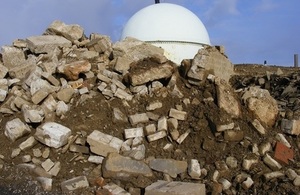Concrete example of dealing with decommissioning rubble
Research is under way to quantify the environmental implications of dealing with the huge quantities of concrete rubble will arise across the NDA’s 17 sites as facilities are demolished following decommissioning and clean-up.

Concrete rubble will arise in large quantities as facilities are demolished
Challenge:
Deal effectively with large quantities of concrete rubble generated by demolition activities across 17 sites
Solution:
Undertake research to analyse available technical evidence, current practices and regulations, with a view to developing protocols and guidance that will help avoid unintended environmental consequences, while reducing costs
| Benefits | Ensuring value for money, environmental good practice and future guidance for industries beyond nuclear |
| Status | First stage of research complete |
| R&D driver | Informing strategy |
| Research organization | AECOM |
Huge quantities of concrete rubble will arise all across the NDA’s 17 sites as nuclear facilities are demolished following decommissioning and clean-up. Some rubble will be radioactive but the vast bulk will be conventional demolition material that could be re-used, for example as landscape material, filling in voids or as aggregate. Re-use on site has the potential to save time, costs and environmental damage by minimising the need to transport rubble for disposal elsewhere, and bring in other materials for void infill or landscaping.
However, recycled concrete-based materials, or RCM, also generate highly alkaline and metal leachate when exposed to water. Leachate can enter groundwater, drainage systems or surface water, altering the surrounding ground characteristics and in turn affecting vegetation and wildlife.
This could undermine the environmental and cost savings, potentially breaching regulatory guidelines.
The NDA has commissioned research to analyse the nature of the risks in greater detail and consider methods for treating RCM before re-use and minimising the potential for leaching.
The quantities are significant: the 10 Magnox reactor sites are estimated to generate 1.3 million tonnes of concrete in the decades ahead. Removing this for disposal at inert landfill sites will require 140,000 truck movements, travelling to and from sites. The estimated cost is almost £150 million.
Re-use of RCM is common in the construction and demolition industries, however, this tends to occur immediately after it has been generated and is used to infill very shallow voids such as roads.
On the other hand, demolishing cleaned-up nuclear facilities with deep foundations at the NDA’s sites (for example, turbine halls or reactor buildings) will create large voids, while stockpiles of RCM may also be stored for decades before re-use is required.
Although the leaching risks are widely known, a range of different regulatory protocols are in use, creating uncertainty and widely varying approaches to management options. RCM is also classified as inert under EU waste legislation, which implies minimal environmental consequences.
Different leachate characteristics also result from the varied range of concrete compositions, coarseness of the rubble, level of compaction, duration of exposure to air/water and surrounding rock/soil types.
The research involved engagement with a range of industries, especially the demolition sector, as well as SLCs. Analysis of available technical literature and consultations with regulators also took place, looking at how crushed concrete rubble has previously been managed and how leachate is assessed, monitored and controlled.
The results bring together, for the first time, a comprehensive outline of the possible environmental consequences of re-using RCM in different scenarios. A series of recommendations will now be developed for SLCs to use when planning demolition projects, as well as proposals for the next steps to drafting and implementing a consistent, rigorous approach.
Further reading
This case study is part of the Direct Research Portfolio Report 2018 to 2019
Also available is the previous DRP Report 2017 to 2018